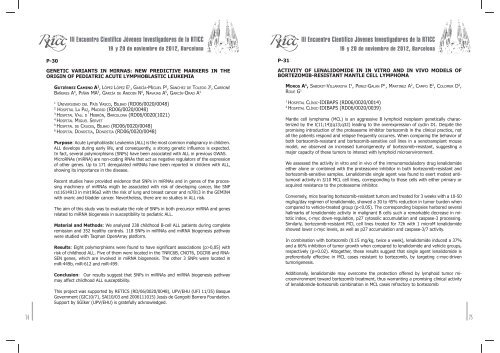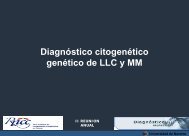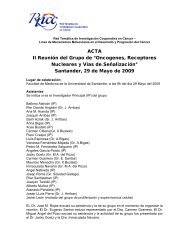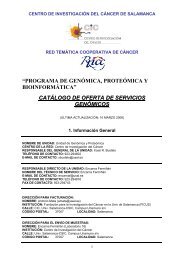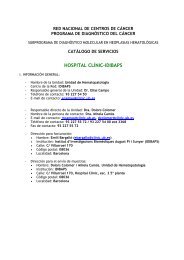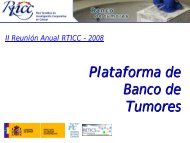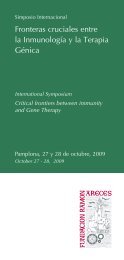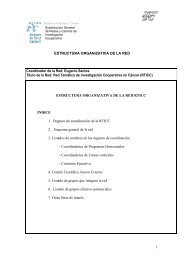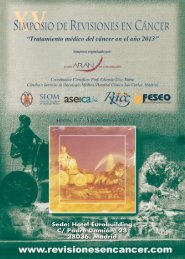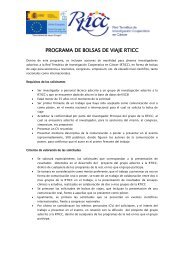Untitled - Red Temática de investigación cooperativa en cáncer
Untitled - Red Temática de investigación cooperativa en cáncer
Untitled - Red Temática de investigación cooperativa en cáncer
Create successful ePaper yourself
Turn your PDF publications into a flip-book with our unique Google optimized e-Paper software.
P-30<br />
GENETIC VARIANTS IN MIRNAS: NEW PREDICTIVE MARKERS IN THE<br />
ORIGIN OF PEDIATRIC ACUTE LYMPHOBLASTIC LEUKEMIA<br />
GUTIÉRREZ CAMINO A 1 , LÓPEZ LÓPEZ E 1 , GARCÍA-MIGUEL P 2 , SÁNCHEZ DE TOLEDO J 3 , CARBONÉ<br />
BAÑERES A 4 , PIÑÁN MA 5 , GARCÍA DE ANDOIN N 6 , NAVAJAS A 5 , GARCÍA-ORAD A 1<br />
1<br />
UNIVERSIDAD DEL PAÍS VASCO, BILBAO (RD06/0020/0048)<br />
2<br />
HOSPITAL LA PAZ, MADRID (RD06/0020/0048)<br />
3<br />
HOSPITAL VALL D´HEBRÓN, BARCELONA (RD06/0020(1021)<br />
4<br />
HOSPITAL MIGUEL SERVET<br />
5<br />
HOSPITAL DE CRUCES, BILBAO (RD06/0020/0048)<br />
6<br />
HOSPITAL DONOSTIA, DONOSTIA (RD06/0020/0048)<br />
Purpose: Acute Lymphoblastic Leukemia (ALL) is the most common malignancy in childr<strong>en</strong>.<br />
ALL <strong>de</strong>velops during early life, and consequ<strong>en</strong>tly, a strong g<strong>en</strong>etic influ<strong>en</strong>ce is expected.<br />
In fact, several polymorphisms (SNPs) have be<strong>en</strong> associated with ALL in previous GWAS.<br />
MicroRNAs (miRNA) are non-coding RNAs that act as negative regulators of the expression<br />
of other g<strong>en</strong>es. Up to 171 <strong>de</strong>regulated miRNAs have be<strong>en</strong> reported in childr<strong>en</strong> with ALL,<br />
showing its importance in the disease.<br />
Rec<strong>en</strong>t studies have provi<strong>de</strong>d evi<strong>de</strong>nce that SNPs in miRNAs and in g<strong>en</strong>es of the processing<br />
machinery of miRNAs migth be associated with risk of <strong>de</strong>veloping cancer, like SNP<br />
rs11614913 in mir196a2 with the risk of lung and breast cancer and rs7813 in the GEMIN4<br />
with ovaric and blad<strong>de</strong>r cancer. Nevertheless, there are no studies in ALL risk.<br />
The aim of this study was to evaluate the role of SNPs in both precursor miRNA and g<strong>en</strong>es<br />
related to miRNA biog<strong>en</strong>esis in susceptibility to pediatric ALL.<br />
Material and Methods: We analyzed 238 childhood B-cell ALL pati<strong>en</strong>ts during complete<br />
remission and 352 healthy controls. 118 SNPs in miRNAs and miRNA biog<strong>en</strong>esis pathway<br />
were studied with Taqman Op<strong>en</strong>Array platform.<br />
Results: Eight polymorphisms were found to have significant associations (p>0,05) with<br />
risk of childhood ALL. Five of them were located in the TNRC6B, CNOT6, DGCR8 and RNA-<br />
SEN g<strong>en</strong>es, which are involved in miRNA biog<strong>en</strong>esis. The other 3 SNPs were located in<br />
miR-449b, miR-612 and miR-499.<br />
Conclusion: Our results suggest that SNPs in miRNAs and miRNA biog<strong>en</strong>esis pathway<br />
may affect childhood ALL susceptibility.<br />
This project was supported by RETICS (RD/06/0020/0048), UPV/EHU (UFI 11/35) Basque<br />
Governm<strong>en</strong>t (GIC10/71, SAI10/03 and 2006111015) Jesús <strong>de</strong> Gangoiti Barrera Foundation.<br />
Support by SGIker (UPV/EHU) is gratefully acknowledged.<br />
P-31<br />
ACTIVITY OF LENALIDOMIDE IN IN VITRO AND IN VIVO MODELS OF<br />
BORTEZOMIB-RESISTANT MANTLE CELL LYMPHOMA<br />
MOROS A 1 , SABORIT-VILLARROYA I 1 , PEREZ-GALAN P 1 , MARTINEZ A 2 , CAMPO E 2 , COLOMER D 2 ,<br />
ROUE G 1<br />
1<br />
HOSPITAL CLÍNIC-IDIBAPS (RD06/0020/0014)<br />
2<br />
HOSPITAL CLÍNIC-IDIBAPS (RD06/0020/0039)<br />
Mantle cell lymphoma (MCL) is an aggressive B lymphoid neoplasm g<strong>en</strong>etically characterized<br />
by the t(11;14)(q13;q32) leading to the overexpression of cyclin D1. Despite the<br />
promising introduction of the proteasome inhibitor bortezomib in the clinical practice, not<br />
all the pati<strong>en</strong>ts respond and relapse frequ<strong>en</strong>tly occurres. Wh<strong>en</strong> comparing the behavior of<br />
both bortezomib-resistant and bortezomib-s<strong>en</strong>sitive cell lines in a x<strong>en</strong>otransplant mouse<br />
mo<strong>de</strong>l, we observed an increased tumorig<strong>en</strong>ecity of bortezomib-resistant, suggesting a<br />
major capacity of these tumors to interact with lymphoid micro<strong>en</strong>vironm<strong>en</strong>t.<br />
We assessed the activity in vitro and in vivo of the immunomoduladory drug l<strong>en</strong>alidomi<strong>de</strong><br />
either alone or combined with the proteasome inhibitor in both bortezomib-resistant and<br />
bortezomib-s<strong>en</strong>sitive samples. L<strong>en</strong>alidomi<strong>de</strong> single ag<strong>en</strong>t was found to exert mo<strong>de</strong>st antitumoral<br />
activity in 3/10 MCL cell lines, corresponding to those cells with either primary or<br />
acquired resistance to the proteasome inhibitor.<br />
Conversely, mice bearing bortezomib-resistant tumors and treated for 3 weeks with a 10-50<br />
mg/kg/day regim<strong>en</strong> of l<strong>en</strong>alidomi<strong>de</strong>, showed a 30 to 45% reduction in tumor bur<strong>de</strong>n wh<strong>en</strong><br />
compared to vehicle-treated group (p


